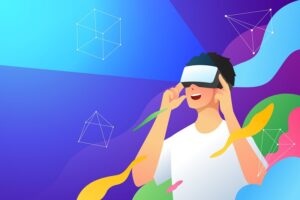What is 2.5D Animation?
2.5D (or 2.5D) Animation may seem like a typo at first glance, but it’s not! Simply put, 2.5D Animation is an animated video content that bridges the gap between 2D and 3D styles. This interesting animation technique combines 2D objects in a 3D space to create a 3D space for the audience. Does that sound complicated? No problem. If you stick with us until the end of this blog, you’ll easily get a good understanding of 2.5D Animation.
Understanding 2.5D Animation
Suppose you have an idea for an animation that would be more interesting in 3D. But for some reason, you don’t have the resources, tools, or budget to make a 3D animation. In that case, 2.5D Animation comes to your rescue. With the 2.5D animation technique, you can display 2D objects in a 3D way. A professional animator, if he cleverly uses various methods such as shading, layering, and perspective adjustments, among many other techniques, can make a 2D object appear voluminous and completely change its appearance. You will better understand what 2.5D Animation is by now. Isn’t that right?
In short, 2.5D Animation is an interesting optical illusion that makes characters and objects actually “2D” appear “3D.” This video style is very practical and popular. Still, it is very useful when you want to produce more visually appealing content in relation to 2D Animation but cannot implement the option of 3D Animation due to time or financial constraints.

Differences between 2D, 2.5D and 3D animation
The art of Animation has come a long way since the days of classic hand-drawn Animation; today, there are three main animation techniques: two-dimensional (2D), two-and-a-half-dimensional (2.5D), and three-dimensional (3D). While all three methods involve creating moving images and characters, they differ significantly in style, production process, and final output.
Here, we will review a summary of the differences between these animation styles so that you can better understand them.
2D Animation
This type of Animation is the so-called most traditional. Although it may seem the simplest, it has a significant impact on attracting the audience through storytelling. This type of Animation is made in a flat, two-dimensional space with flat characters and objects.
Animators draw characters, backgrounds, and other elements in 2D and then move them around on the screen or 2D background using special techniques to create Animation.
Many of our childhood and teenage memories are made with this type of Animation. Old Disney animations, such as The Little Mermaid and Snow White, Family Guy, and Rick and Morty, are all good examples of 2D Animation.
3D Animation
Of the three video animation styles we will discuss here, 3D Animation is the most time-consuming style compared to the others. Producing 3D videos involves many more steps; that is why it can best portray the depth of characters and backgrounds. While it can probably be the most visually appealing animation style, it is also the most expensive.
3D Animation involves creating 3D models of a space’s characters, objects, and environments. Animators use specialized software to edit and animate 3D models, creating movement and depth that is not possible with 2D Animation.
3D Animation is often used in films, television shows, and video games to create environments and realistic character designs. Traditional animation techniques cannot achieve these visual effects.
2.5D Animation
As we mentioned earlier, this style combines 2D and 3D Animation techniques. The background is flat, but the characters and objects appear in 3D. Thus, those original “3D” elements become the focus of the audience’s attention.
To create this type of Animation, animators first draw or create 2D images and characters using traditional or digital techniques. They then use 3D animation software to manipulate and edit the position, rotation, and scale of 2D elements to create volume, depth, and movement.
3D software acts as a camera that moves around the 2D images and creates a 3D environment using various effects.

Uses of 2.5D Animation
Movies and TV Shows
2.5D Animation is often used in movies and TV shows to create animated opening sequences. This technique allows animators to create stunning animations that capture the audience’s attention.
Advertising
2.5D Animation is also used in advertising to design commercials and create motion graphics. This technique allows companies to showcase their products or services in an attractive way.
Video Games
Game development also uses 2.5D Animation to create 2D game environments with a 3D appearance. This helps game developers provide a 3D and immersive gaming experience while minimizing the amount of 3D design required, making game development easier and faster.
Virtual Reality
2.5D Animation can also be used in virtual reality to create “3D” environments. This helps programmers and designers create 3D environments with 2D characters and objects, creating a unique VR experience.

Advantages of 2.5D Animation
2.5D Animation has several advantages over 2D and 3D techniques; here are some benefits of 2.5D Animation.
So, if you still need to decide which option to choose, here are seven main reasons why 2.5D Animation could be your best choice.
Faster production time
Since 2.5D Animation requires less modeling and rendering time, it can be produced faster than 3D animation techniques. This makes this animation style ideal for fast-paced projects and tight deadlines.
Increased visual depth
With 2.5D Animation, you have 100% more visual depth than 2D Animation. This gives characters and objects a 3D look while still maintaining the appeal of 2D Animation.
More flexibility and better
With its flexibility, 2.5D Animation allows animators to combine 2D and 3D elements to create unique special effects, allowing them to create a wider range of visual styles and techniques.
Easy integration with other software
When creating 2.5D Animation in one software, it is easy to integrate and transfer it to other software, allowing animators to work seamlessly between 2D and 3D software. This makes it easier to create complex animations with multiple elements.
Versatile
As we’ve seen before, 2.5D Animation has various uses, making it an ideal choice for multiple projects due to its versatility across industries.
It saves time and money.
Whether you’re a startup or have a tight budget, you can still use this video style to boost your marketing. It’s a cost-effective alternative to 3D and live-action videos because it doesn’t require complicated equipment or actors. It’s also easier to create, so you don’t have to wait months for the final file.
Audience engagement
The unique format of these videos makes them eye-catching content, and you should keep that in mind if you want your business to stand out from the crowd. Additionally, people generally connect more with video content, and what’s better than having a good, engaging animated video that helps your audience better understand your business?
How to Make a 2.5D Animation
Although it seems relatively straightforward, creating a 2.5D animation still requires the expertise and skills of an animator and character designer. If you don’t have enough skills to do it yourself, you can easily leave it to the best experts by defining and registering the project and hiring a freelancer on Carlancer. Creating a 2.5D animation involves combining 2D and 3D elements. Here, we will review a few main steps in creating a 2.5D animation.

Ideating and designing a concept
The first step is to create and design a concept for your Animation. This includes creating a storyboard that outlines the story, characters, and environment. You need to provide the basic requirements to get started and brainstorm ideas at this stage.
Designing 2D Elements
The next step is designing the 2D elements of the Animation. This step involves drawing the characters and background in 2D software such as Adobe Photoshop or Illustrator.
Converting 2D Elements to 3D
Once you have created your 2D elements, you must convert them to 3D. This step involves importing these 2D elements into 3D modeling software such as Maya or Blender and creating a 3D model (using specific drawing techniques) for each component.
Adding Camera Movement
The next step is to add third-person camera movement to your Animation. This involves creating a camera path that moves through the 3D environment and captures the desired action.
Adding Lighting and Shadows
Now, it’s time to give your Animation a more realistic feel. Once you’ve added camera movement, you must add lighting and shadows to your Animation. This involves creating light sources in the animation space and adjusting the shadows to create a more realistic and “3D” look.
Rendering the Animation
Rendering is the final step in creating your 2.5D Animation. You must export your Animation as a video file or image sequence.